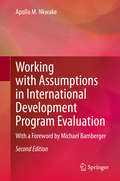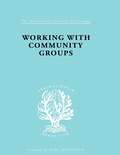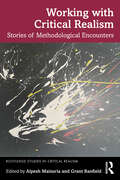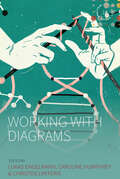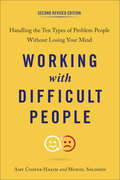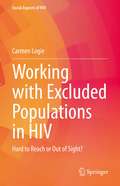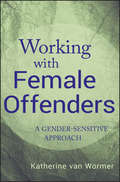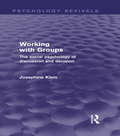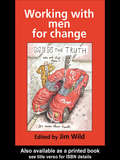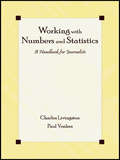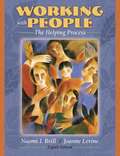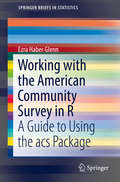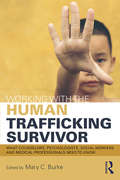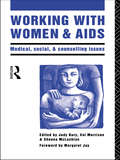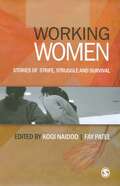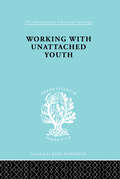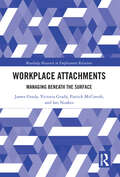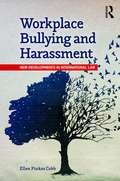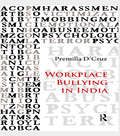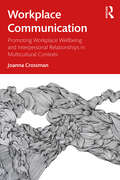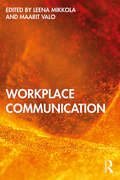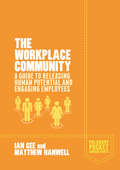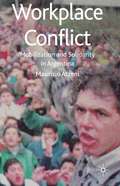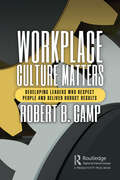- Table View
- List View
Working with Assumptions in International Development Program Evaluation: With a Foreword by Michael Bamberger
by Apollo M. NkwakeThis book discusses the crucial place that assumptions hold in conceptualizing, implementing, and evaluating development programs. It suggests simple ways for stakeholders and evaluators to 1) examine their assumptions about program theory and environmental conditions and 2) develop and carry out effective program monitoring and evaluation in light of those assumptions. A survey of evaluators from an international development agency reviewed the state of practice on assumptions-aware evaluation. This 2nd edition has been updated with further illustrations, case studies, and frameworks that have been researched and tested in the years since the first edition.Regardless of geography or goal, development programs and policies are fueled by a complex network of implicit ideas. Stakeholders may hold assumptions about purposes, outcomes, methodology, and the value of project evaluation and evaluators—which may or may not be shared by the evaluators. A major barrier to viable program evaluations is that development programs are based on assumptions that often are not well articulated. In designing programs, stakeholders often lack clear outlines for how implemented interventions will bring desired changes. This lack of clarity masks critical risks to program success and makes it challenging to evaluate such programs. Methods that have attempted to address this dilemma have been popularized as theory of change or other theory‐based approaches. Often, however, theory-based methods do not sufficiently clarify how program managers or evaluators should work with the assumptions inherent in the connections between the steps. The critical examination of assumptions in evaluation is essential for effective evaluations and evaluative thinking. "How does one think evaluatively? It all begins with assumptions. Systematically articulating, examining, and testing assumptions is the foundation of evaluative thinking… This book, more than any other, explains how to build a strong foundation for effective interventions and useful evaluation by rigorously working with assumptions." —Michael Quinn Patton, PhD. Author of Utilization-Focused Evaluation and co-editor of THOUGHTWORK: Thinking, Action, and the Fate of the World, USA. "This updated edition presents us with a new opportunity to delve into both the theoretical and practical aspects of paradigmatic, prescriptive, and causal assumptions. We need to learn, and apply these insights with the deep attention they deserve." —Zenda Ofir, PhD. Independent Evaluator, Richard von Weizsäcker Fellow, Robert Bosch Academy, Berlin, Germany. Honorary Professor, School of Public Leadership, Stellenbosch University, South Africa. “This thought-provoking book explains why assumptions are an essential condition within the theories and methodologies of evaluation; and how assumptions influence the ways that evaluators approach their work…It will enrich the ways that evaluators develop their models, devise their methodologies, interpret their data, and interact with their stakeholders.”—Jonny Morell, Ph.D., President, 4.669… Evaluation and Planning, Editor Emeritus, Evaluation and Program Planning
Working with Community Groups: Using Community Development as a Method of Social Work ILS 198 (International Library of Sociology)
by George W GoetschiusA report of the development of a service to housing estate community groups by the London Council of Social Service, based on 15 years of field work experience using the community development approach and method. First Published in 1969. Routledge is an imprint of Taylor & Francis, an informa company.
Working with Critical Realism: Stories of Methodological Encounters (Routledge Studies in Critical Realism)
by Alpesh Maisuria Grant BanfieldThis international and interdisciplinary collection gathers stories from researchers and research students about their methodological encounters with critical realism. Whether the contributors are experienced or novice researchers, they are predominantly new to critical realism. For various reasons, as the contributors’ detail, they have all been drawn to critical realism. It is well known that critical realism can be bewildering and even overwhelming to newcomers, especially to those unfamiliar with language of, and without a grounding in, philosophy. While there are now numerous and important introductory and applied critical realist texts that make critical realism more accessible to a broader audience, stories from newcomers have been absent – especially as part of a single collection. The significance and uniqueness of this collection lies in its documentation of first-hand reflective insights on the practical use and implementation of critical realism. The contributors feature critical realist inspired research journeys in Australia, England, Scotland, Belgium, Sweden, and Spain. The hope of this book is that the stories and accounts presented in it will inspire – or at least sufficiently arouse – the curiosity of others to explore critical realist possibilities, which we believe offer enormous value to serious researchers across and within all disciplines and subjects who are interested in rigorous intellectual work with a socially progressive purpose.
Working With Diagrams (Studies in Social Analysis #14)
by Lukas Engelmann, Caroline Humphrey Christos LynterisArising from the need to go beyond the semiotic, cognitive, epistemic and symbolic reading of diagrams, this book looks at what diagrams are capable of in scholarly work related to the social sciences. Rather than attempting to define what diagrams are, and what their dietic capacity might be, contributions to this volume draw together the work diagrams do in the development of theories. Across a range of disciplines, the chapters introduce the ephemeral dimensions of scientist’s interactions and collaboration with diagrams, consider how diagrams configure cooperation across disciplines, and explore how diagrams have been made to work in ways that point beyond simplification, clarification and formalization.
Working with Difficult People, Second Revised Edition: Handling the Ten Types of Problem People Without Losing Your Mind
by Muriel Solomon Amy Cooper HakimA revised edition of the classic guide on how to best resolve conflict in today's technologically advanced workplace.Your work day is filled with them--people who frustrate, impede, maneuver, undermine, plot, connive, and whine. This indispensable guide details specific techniques for handling all of them, with easy-to-follow scenarios for every situation. Updated and revised to reflect modern issues including technology, generation gaps, and language barriers, this guide describes 10 kinds of culprits, from tyrants and bullies (regular and cyber) to the pushy and presumptuous to connivers and camouflagers; and offers helpful strategies and phrases for diffusing workplace tensions and effectively resolving conflicts.From the Trade Paperback edition.
Working with Excluded Populations in HIV: Hard To Reach Or Out Of Sight? (Social Aspects Of Hiv Ser. #8)
by Carmen LogieThis book, written decades into the HIV epidemic, reflects critically on the idea that the socially excluded populations often focused on in HIV research are in fact difficult to access and reach. The author broadly applies the concept ‘hard to reach’ to characterize populations that researchers find difficult to engage with. Social factors that produce marginalization and ultimately result in people choosing not to engage in research are not captured by the concept of ‘hard to reach’. Limited attention has focused on how researchers can address the social factors that result in decisions to not engage in research. Disrupting the ways in which people are conceptualized as ‘hard to reach’ so as to refocus on transforming social systems and personal values, beliefs and approaches is understudied. This book uses case examples based on HIV research with Indigenous youth, internally displaced women, LGBTQ communities in the Global North and Global South, and persons at the intersection of these identities, to identify successful approaches to working with marginalized and often vulnerable communities and groups. The chapters signal the need for attention to five key social factors when developing successful approaches: context and storytelling; cultural humility; critical hope; imagination and possibility; and love, intimate inquiry, and the beloved community, if nations, individuals and communities are to address the epidemic in a sustainable and impactful way.
Working with Female Offenders
by Katherine Van WormerThe first book to combine elements from the social work, counseling, and criminology fields to create a framework tailored to working with female offenders. Taking into account the special needs of girls and women within a system designed by men for male offenders, Working with Female Offenders offers counselors, correctional officers, lawyers, probation officers--in short, anyone who works in some capacity with female offenders-an evidence-based, gentler approach for working effectively and successfully with girls and women in trouble with the law.Working with Female Offenders provides coverage devoted to the nature of female crime and to the institutional settings in which much of the female-specific programming is designed to take place. This timely volume equips professionals with proven counseling strategies tailored to fit this population.Practical guidelines are included for case management interventions, teaching skills of communication and assertiveness, and anger and stress management for female offender populations, as well as: A strengths/empowerment/restorative framework for counseling women in crisis. Narratives from personal interviews with female offenders and correctional counselors. Discussion of controversial topics such as prison homosexuality, AIDS in prison, girls in gangs, and women on death row. Examples of successful, innovative programs for female offenders from the United States and abroad. Working with Female Offenders addresses the unique challenges of female offenders and those who treat them, and provides a much needed addition to the literature on innovative programming for female offenders.
Working with Groups: The Social Psychology of Discussion and Decision (Psychology Revivals)
by Josephine KleinOriginally published in 1963, this book was one of the first to explore group process and working with groups. The introductory chapter tells us that working with groups requires three skills: and understanding of theory, a knowledge of its application, and trained experience in its use. It goes on to discuss these points, helping the reader towards an understanding of group processes and making decisions in groups. This title is an early example of author’s explorations of groups and group work, which were to be a major factor in the establishment of group-work practice in Britain over the following years.
Working With Men For Change (Gender, Change, And Society Ser.)
by Jim Wild. Wild, JimThis is a work that reflects the growing interest in issues relating to men and masculinities. This diverse collection by a team of contributors analyzes the composition and representation of masculine identities. Combining research with theory and strategies for activism, the work promotes practical ways of working with men to achieve change. Intentionally designed as a handbook, it provides effective and practical information for professionals in social welfare settings, trainers and activists in the community, as well as individual men who have their own personal agenda for change.
Working With Numbers and Statistics: A Handbook for Journalists
by Charles Livingston Paul S. VoakesWorking With Numbers and Statistics: A Handbook for Journalists will bolster math skills and improve math confidence for journalists at all skill levels. Authors Charles Livingston and Paul Voakes developed this resource book to improve journalistic writing and reporting, enabling journalists to:*make accurate, reliable computations, which in turn enables one to make relevant comparisons, put facts into perspective, and lend important context to stories;*recognize inaccurate presentations, whether willfully spun or just carelessly relayed;*ask appropriate questions about numerical matters;*translate complicated numbers for viewers and readers in ways they can readily understand;*understand computer-assisted reporting; and*write livelier, more precise pieces through the use of numbers.The math is presented in a journalistic context throughout, enabling readers to see how the procedures will come into play in their work.Working With Numbers and Statistics is designed as a reference work for journalism students developing their writing and reporting skills. It will also serve professionals as a useful tool to improve their understanding and use of numbers in news stories.
Working With People: The Helping Process
by Naomi Brill Joanne LevineThis text for students in social work and other helping professions examines the theoretical foundations of social work practice and encourages the development of practice skills. This eighth edition emphasizes advocacy for clients, and contains expanded material on managed care, privatization, and HIV/AIDS. Discussion of feminist psychology, brief therapies, and the role of the Internet in the human services field is also new to this edition. Levine is affiliated with Wichita State University. Information on Brill is not provided.
Working with the American Community Survey in R
by Ezra Haber GlennThis book serves as a hands-on guide to the "acs" R package for demographers, planners, and other researchers who work with American Community Survey (ACS) data. It gathers the most common problems associated with using ACS data and implements functions as a package in the R statistical programming language. The package defines a new "acs" class object (containing estimates, standard errors, and metadata for tables from the ACS) with methods to deal appropriately with common tasks (e. g. , creating and combining subgroups or geographies, automatic fetching of data via the Census API, mathematical operations on estimates, tests of significance, plots of confidence intervals).
Working with the Human Trafficking Survivor: What Counselors, Psychologists, Social Workers and Medical Professionals Need to Know
by Mary C. BurkeWorking with the Human Trafficking Survivor fills a void in existing literature by providing students, faculty, and professionals in applied, helping disciplines, with a comprehensive text about human trafficking with a focus on clinical issues. This book gives an overview of the medical care, options for psychological treatment, and beyond. Working with the Human Trafficking Survivor fills is a great resource for social work, counselling, and psychology courses on human trafficking or domestic violence.
Working With Traumatized Youth In Child Welfare (Social Work Practice With Children And Families)
by Nancy Boyd Webb James R. DumpsonUntil recently, there has not been a great deal of overlap in the child welfare and trauma literatures. This text bridges that divide by integrating perspectives from both fields to help practitioners understand and address the special needs of maltreated children and adolescents and their families. Current knowledge on attachment, trauma, and risk and resilience is clearly explained, including the impact of abuse on the brain. Readers learn how to conduct assessments and implement a range of effective helping strategies with youth in foster care and other settings. Featuring extensive case illustrations, the book gives particular attention to diversity issues and the importance of supporting child and family strengths.
Working with Women and AIDS: Medical, Social and Counselling Issues
by Judy Bury Val Morrison Sheena McLachlanWomen now account for one third of the ten million people with HIV infection worldwide. Yet until very recently most services were geared towards men, and doctors and other professionals were often unprepared for the particular issues that women would raise. Working with Women and AIDS provides a unique and readable combination of up-to-date medical information, a discussion of social issues, personal accounts and practical advice about ways of working with women affected by HIV and AIDS. Written by people working in the field, the book explores issues such as contraception, pregnancy and prostitution, which are of central concern to those involved in the care of the increasing number of women affected by HIV infection and AIDS.
Working Women: Stories of Strife, Struggle and Survival
by Kogi Naidoo Fay PatelThis book contains narratives pertaining to the challenges, struggles and success stories of women in the workplace who come from diverse cultures and social backgrounds. The essays discuss the struggles of women who were marginalised but who fought for recognition, dignity, and respect in their workplaces and personal lives. The narratives cross cultural boundaries presenting multiple dimensions of the struggle and success of women from different walks of life. Working Women: Stories of Strife, Struggle and Survival brings hope for those who continue to suffer in silence. This multi-cultural anthology of essays highlights women′s perspectives on a wide range of issues: survival in the workplace, spirituality and religion, empowerment and financial independence, and health and wellness. It provides a space for women to present their lived realities within a global context. Given its racy and lucid narrative style, this book would interest a wide readership including working women from various backgrounds, women′s groups and non-governmental organizations. It would also interest those involved in women′s studies, gender studies, organisational culture and communication, sociology and human resource management.
Workng With Unat Youth Ils 148 (International Library of Sociology)
by George W. Goetschius M. Joan TashFirst published in 1998. Routledge is an imprint of Taylor & Francis, an informa company.
Workplace Attachments: Managing Beneath the Surface (Routledge Research in Employment Relations)
by James Grady Victoria Grady Patrick McCreesh Ian NoakesHow fast can your organization change? How long does it take to adopt new technology? Do things run the same when you bring in a new leader? How does the culture evolve with new acquisitions? There is an underlying thread in all these questions. Workplace attachment or our instinctual (biological) response to attach to both tangible and intangible objects continuously throughout life. Workplace Attachments: Managing Beneath the Surface provides the first comprehensive review of attachment in the workplace. We explore the biological and evolutionary roots of our attachments, explain how you can find attachment behaviour in your workplace, and help you proactively understand attachment behaviour with your team. Our practical research, case studies, and story-telling will help you understand how attachment behaviour impacts you, your employees, your peers and ultimately the culture of your organization. Once you understand how people attach, detach, and re-attach to objects and elements of your organization, you will be able to real and lasting change.
Workplace Bullying and Harassment: New Developments in International Law
by Ellen Pinkos CobbWorkplace Bullying and Harassment: New Developments in International Law provides a comprehensive tour around the globe, summarizing relevant legislation and key developments in workplace bullying, harassment, sexual harassment, discrimination, violence, and stress in over 50 countries in Europe, the Asia Pacific region, the Americas region, and the Middle East and Africa. Workplace bullying, harassment, and other psychological workplace hazards are becoming increasingly acknowledged and legislated against in the modern work world. The costs of bullying, harassment, violence, discrimination, and stress at work are huge and far-reaching. Frequently under-reported and misunderstood, workplace bullying, harassment, violence, discrimination, and stress wreak havoc on the vitality and prosperity of organizations and individuals alike. Workplace laws have long dealt with physical risks, and psychological risks have begun to be treated similarly. In response to the changing workplace, many countries are regulating workplace bullying and harassment by introducing new legislation or incorporating new provisions into existing legislation to address these risks. Other countries have opted for non-regulatory instruments. Numerous European countries, Canada, Australia, and Japan all prohibit and punish workplace bullying and harassment, with other countries, including the United States of America, moving toward legislation against this abusive workplace conduct. This book brings together need-to-know information on global workplace bullying and harassment in one place, the first publication of its kind to do so. It will aid those in the fields of labor and employment, human resources management, occupational and industrial health psychology, health and safety, and workplace regulatory compliance stay abreast of laws and developments that these practitioners must be aware of, whether operating nationally or globally. Academics will also benefit. Links to laws and references are provided, enabling further research.
Workplace Bullying in India
by Premilla D'CruzWorkplace bullying, a pattern of persistent and targeted emotional abuse within the context of an evolving unequal interpersonal relationship, has so far not received academic attention in India. This book explores the phenomenon of workplace bullying through a series of quantitative and qualitative inquiries conducted in India’s Information Technology-Enabled Services–Business Process Outsourcing (ITES-BPO) sector. Through quantitative evidence from two multi-city surveys, the book highlights the incidence of interpersonal bullying at work and the organizational measures available to deal with it. Over one-third of the survey respondents experienced bullying, which was usually from superiors though cross-level co-bullying was also reported. Approximately 70 per cent of the survey respondents described organizational measures including anti-bullying policies, employee awareness and training programmes, encouragement of witnesses/bystanders to intervene in bullying situations, and organizational actions. Through qualitative data, the book provides insights into both interpersonal and depersonalized bullying. The lived experiences of targets and witnesses/bystanders of interpersonal bullying underscore the critical influence of human resources management (HRM) on target coping, the long-term identity work targets engage in as they respond to identity disruptions and the effect of workplace friendship on witnesses’/bystanders’ behaviour. The presence of institutionalized bullying facilitates the development of the emergent construct of depersonalized bullying. Across both quantitative and qualitative inquiries, the inclusion of socio-cultural, micro-organizational, macro-organizational, and business, dimensions deepens our understanding. The book goes beyond a country-specific contribution to address gaps in the international literature on workplace bullying and will be of interest to academics and practitioners in the fields of management, organizational behaviour (OB), human resources (HR), industrial relations, psychology, sociology, anthropology, and law as well as to the general reader.
Workplace Communication: Promoting Workplace Wellbeing and Interpersonal Relationships in Multicultural Contexts
by Joanna CrossmanWorkplace Communication highlights how we can build interpersonal relationships through effective communication and why this is essential to workplace wellbeing. Well-supported by contemporary, reputable empirical studies, the book also comes with exercises and open-ended questions based on the subject matter. The book provides a comprehensive overview on creating an inclusive workplace and managing workplace diversity; covers a wide range of salient, up-to-date reputable literature on a wide range of management and business topics; contains practical, ‘road-tested’ activities to promote student reflection, experiential learning, critical thinking, research skills, and application of theory to practice and vice versa; examines how we communicate effectively to an increasingly diverse workforce. Designed for a broad audience, this book will appeal to academics and students in the fields of business management and communications. It will also be a useful reference for organisational practitioners and leaders.
Workplace Communication
by Leena Mikkola Maarit ValoThis book provides insights into communication practices that enable efficient work, successful collaboration, and a functional work environment. Maintaining a productive and healthy workplace is predicated on interpersonal communication between people. In organizations, efficient communication is the foundation of all actions. Contributors to this book cover communication issues in relationships, teams, meetings, leadership, competence, diversity, organizational entry, social support, and digital environments in the workplace. The book illustrates all these issues in detail by presenting both relevant research findings and their practical implications in working life. Workplace Communication is ideal for current and future employees, directors, supervisors and managers, instructors, and consultants in knowledge-based expertise work. The book is appropriate for courses in organizational and leadership communication or interpersonal communication in a workplace setting.
The Workplace Community
by Ian GeeThe Workplace Community offers a structured, practical guide to developing collaborative knowledge-based communities in the workplace, from introducing employees and managers to new ways of working, to measuring effectiveness and providing corrective interventions for those who haven't achieved the desired results.
Workplace Conflict
by Maurizio AtzeniBased on qualitative work in car plants in Argentina, this bookoffers new insights for an understanding of workers' collective struggles in a radical perspective. Criticizing the use of injustice as the basis of mobilization, it argues that workers' collective resistance should be seen as a function of the development of solidarity. "
Workplace Culture Matters: Developing Leaders Who Respect People and Deliver Robust Results
by Robert B. CampWritten in a novel format, this book addresses the challenge of changing a "sick" culture. Some organizations wake up one day and realize they have become something they never intended. Their employees run scared. There is no innovation, only blind obedience. There are warlords within the ranks of management, and they fight over turf without considering the best interests of customers, their employees, or their organization as a whole. At the Charleston, SC, branch of Copper-Bottom Insurance, the wakeup call comes when an employee files a lawsuit against the company and its leaders. The Charleston division Vice President, Jack Simmons, is put on probation and given an ultimatum: "Change the culture!" Jack understands the "or be fired" implication all too well. He scrambles to find help and runs into an old friend, Don Spears, from Friedman Electronics. With Don’s help, Jack begins the journey that will heal his organization. In the course of their first visit, Don and his Director of Continuous Improvement, Tim Stark, help Jack to make an important discovery: Copper-Bottom’s executives are not showing their people respect. Don and Tim point to the following observations as proof. Copper-Bottom leaders are Using top-down, "command-and-control" leadership behaviors rather than recognizing their people as Subject Matter Experts and listening to them Issuing instructions to their people rather than observing then improving performance through coaching Keeping employees in the dark as to the impact their work has on the organization’s mission Unaware of the obstacles in their people’s paths; hence, never using the authority of their positions to remove those obstacles Staying in their offices, aloof to the difficulties their subordinates face As Don and Tim see it, Copper-Bottom’s problems stem from the way its leaders lead. After the executive who precipitated the lawsuit is let go, the Friedman team begins the process of teaching Copper-Bottom’s executives that a healthy culture begins at the leadership level. Don, Friedman’s General Manager, states that cultures change when their leaders change. In short, leaders need to initiate the changes in the culture by first demonstrating the desired behavior. So begins the process of reeducating Copper-Bottom’s leaders in the difference between managing and leading. In short order, Tim begins to work with Jack’s leadership team while Don takes Jack to Friedman’s Oakland facility. There Jack learns To first concentrate on surrounding himself with the right people The importance of top-down metrics to which leaders first hold themselves accountable Cascading their metrics (KPIs) down through their organization and using a dialog about them as a way of developing relationships of respect Although a long way from complete, by the end of Jack’s six-month probation, Copper-Bottom has made significant strides and is well on its way to changing its culture. Jack will learn that he is not the only one to appreciate the new developments.
